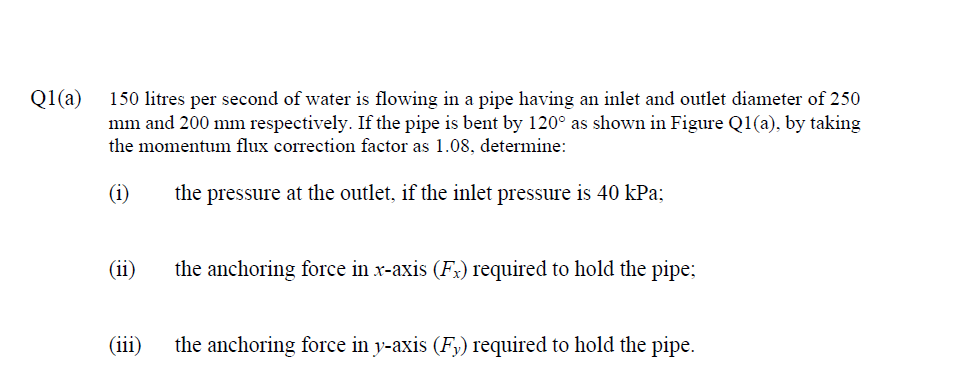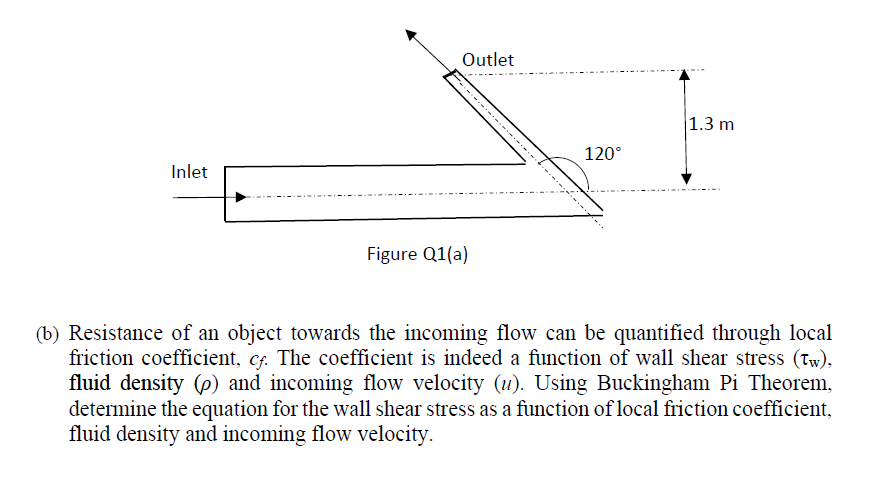(b) Resistance of an object towards the incoming flow can be quantified through local friction coefficient, cf. The coefficient is indeed a function of wall shear stress (Tw), fluid density (p) and incoming flow velocity (u). Using Buckingham Pi Theorem, determine the equation for the wall shear stress as a function of local friction coefficient, fluid density and incoming flow velocity.
(b) Resistance of an object towards the incoming flow can be quantified through local friction coefficient, cf. The coefficient is indeed a function of wall shear stress (Tw), fluid density (p) and incoming flow velocity (u). Using Buckingham Pi Theorem, determine the equation for the wall shear stress as a function of local friction coefficient, fluid density and incoming flow velocity.
Elements Of Electromagnetics
7th Edition
ISBN:9780190698614
Author:Sadiku, Matthew N. O.
Publisher:Sadiku, Matthew N. O.
ChapterMA: Math Assessment
Section: Chapter Questions
Problem 1.1MA
Related questions
Question

Transcribed Image Text:Q1(a)
150 litres per second of water is flowing in a pipe having an inlet and outlet diameter of 250
mm and 200 mm respectively. If the pipe is bent by 120° as shown in Figure Q1(a), by taking
the momentum flux correction factor as 1.08, determine:
(i)
the pressure at the outlet, if the inlet pressure is 40 kPa;
(ii)
the anchoring force in x-axis (Fx) required to hold the pipe;
(iii)
the anchoring force in y-axis (F,) required to hold the pipe.

Transcribed Image Text:Outlet
1.3 m
120°
Inlet
Figure Q1(a)
(b) Resistance of an object towards the incoming flow can be quantified through local
friction coefficient, cf. The coefficient is indeed a function of wall shear stress (Tw),
fluid density (p) and incoming flow velocity (u). Using Buckingham Pi Theorem,
determine the equation for the wall shear stress as a function of local friction coefficient,
fluid density and incoming flow velocity.
Expert Solution
This question has been solved!
Explore an expertly crafted, step-by-step solution for a thorough understanding of key concepts.
This is a popular solution!
Trending now
This is a popular solution!
Step by step
Solved in 2 steps with 2 images

Knowledge Booster
Learn more about
Need a deep-dive on the concept behind this application? Look no further. Learn more about this topic, mechanical-engineering and related others by exploring similar questions and additional content below.Recommended textbooks for you

Elements Of Electromagnetics
Mechanical Engineering
ISBN:
9780190698614
Author:
Sadiku, Matthew N. O.
Publisher:
Oxford University Press

Mechanics of Materials (10th Edition)
Mechanical Engineering
ISBN:
9780134319650
Author:
Russell C. Hibbeler
Publisher:
PEARSON

Thermodynamics: An Engineering Approach
Mechanical Engineering
ISBN:
9781259822674
Author:
Yunus A. Cengel Dr., Michael A. Boles
Publisher:
McGraw-Hill Education

Elements Of Electromagnetics
Mechanical Engineering
ISBN:
9780190698614
Author:
Sadiku, Matthew N. O.
Publisher:
Oxford University Press

Mechanics of Materials (10th Edition)
Mechanical Engineering
ISBN:
9780134319650
Author:
Russell C. Hibbeler
Publisher:
PEARSON

Thermodynamics: An Engineering Approach
Mechanical Engineering
ISBN:
9781259822674
Author:
Yunus A. Cengel Dr., Michael A. Boles
Publisher:
McGraw-Hill Education

Control Systems Engineering
Mechanical Engineering
ISBN:
9781118170519
Author:
Norman S. Nise
Publisher:
WILEY

Mechanics of Materials (MindTap Course List)
Mechanical Engineering
ISBN:
9781337093347
Author:
Barry J. Goodno, James M. Gere
Publisher:
Cengage Learning

Engineering Mechanics: Statics
Mechanical Engineering
ISBN:
9781118807330
Author:
James L. Meriam, L. G. Kraige, J. N. Bolton
Publisher:
WILEY